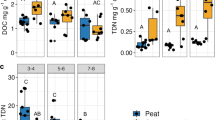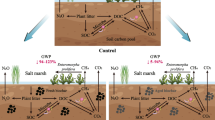Abstract
Free living diazotrophic bacteria are known to enrich nitrogen of organic matter sources. In this paper we report of experiments using rock biofertilizers mixed with two types of organic matter (earthworm compound and ice cream waste) inoculated with free living diazotrophic bacteria. The earthworm compound and P and K biofertilizers were mixed to form substrates S1 (earthworm compound 3 dm3 + PK biofertilizer 1 dm3 and waste ice cream 1 dm3); S2 (earthworm compound 2.5 dm3 + PK biofertilizer 1.5 dm3 and waste ice cream 1 dm3L) and S3 earthworm compound 2.0 dm3 + PK biofertilizer 2.0 dm3 and waste ice cream 1 dm3), and subsequently inoculated (100 mL pot−1) with 3 free living diazotrophic bacteria isolated from different Brazilian soils. The control was an uninoculated earthworm compound. Samples were collected at various incubation time (0; 15; 30 and 45 days) and analyzed for total N. Total N concentrations were highest in S1, S2 and S3 substrates at 34, 27 and 29 days, respectively. The isolate NFB 1001 increased total N in all substrates and the best results were obtained at 34 days in S1 substrate which contained the highest amount of earthworm compound. The isolates promoted a decline in N content after 30 days of growth, indicating the best time to produce the organic biofertilizer. The organic biofertilizer enriched in nitrogen by free living diazotrophic bacteria is of relevance to organic agriculture.




Similar content being viewed by others
References
Baldani JI, Caruso L, Baldani VL, Goe SR, Döbereiner J (1997) Recent advances in BNF with non-legume plants. Soil Biol Biochem 29:911–922
Baldani JI, Reis VM, Baldani VLD, Döbereiner J (2002) A brief story of nitrogen fixation in sugarcane—reasons for success in Brazil. Funct Plant Biol 29:417–423
Ben Rebah F, Tyagi RD, Prévost D (2002) Wastewater sludge as a substrate for growth and carrier for rhizobia: the effect of storage conditions on survival of Sinorhizobium meliloti. Bioresour Technol 83:145–151
Bergersen FJ, Hipsley EH (1970) The presence of N2-fixing bacteria in the intestines of man and animals. J Gen Microbiol 60:61–65
Boddey RM, Sá JC, Alves BJ, Urquiaga S (1997) The contribution of biological nitrogen fixation to sustainable agricultural systems in the tropics. Soil Biol Biochem 29:787–799
Dakora FD, Keya SO (1997) Nitrogen fixation in sustainable agriculture: the African experience. Soil Biol Biochem 29:809–818
Döbereiner J (1961) Enriquecimento do composto do lixo com bactérias fixadoras de nitrogênio atmosférico. Rio de Janeiro. Instituto de Pesquisa Agropecuária 10p. (Comunicado Técnico n. 11)
Döbereiner J (1967) Efeito da inoculação de sementeiras de sabiá (Mimosa caesalpiniifolia) no estabelecimento e desenvolvimento de mudas no campo. Pesquisa Agropecuária Bras 2:301–305
Döbereiner J (1989) Isolation and identification of root associated diazotrophs. In: Skinner FA, Boddey RM, Fendrik I (eds) Nitrogen fixation with non-legumes. Kluwer Academic, Dordrecht, pp 103–108
Embrapa – Empresa Brasileira de Pesquisa Agropecuária (1997) Manual de Métodos de Análise de solo. Rio de Janeiro, p 212
Febrer MCA (2002) Dinâmica da decomposição mesofílica de resíduos orgânicos misturados com águas residuárias da suinocultura. Engenharia Agrícola 10:18–30
Figueiredo MVB, Stamford NP, Vidor C, Vilar JJ, Oliveira Filho EC (1992) Sobrevivência do Bradyrhizobium sp. em substratos alternativos. Pesquisa Agropecuária Bras 27:1497–1506
Garcia Junior O (1991) Isolation and characterization of Thiobacillus thiooxidans and Thiobacillus ferrooxidans from mineral mines. Braz J Microbiol 20:1–6
Hardy RW, Burns RC, Holsten RD (1973) Application of the acetylene-ethylene assay for measurement of nitrogen fixation. Soil Biol Biochem 5:945–950
Hill NM, Patriquin DG (1996) Maximizing N2 fixation in sugarcane litter. In: International symposium on sustainable agriculture for the tropics—the role of biological nitrogen fixation, programme and abstracts. Seropédica, Embrapa-CNPAB, p 59–60
Marshall TJ, Holmes JW (1988) Soil physics. Cambridge University Press, Cambridge
Moura PM, Stamford NP, Duenhas LH, Santos CERS, Nunes GHS (2007) Eficiência de biofertilizantes de rochas com Acidithiobacillus em melão, no Vale do São Francisco. Rev Bras Ciência Agrária 2:1–7
Nishanth D, Biswas DR (2008) Kinetics of phosphorus and potassium release from rock phosphate and waste mica enriched compost and their effect on yield and nutrient uptake by wheat (Triticum aestivum). Bioresour Technol 99:3342–3353
Nóbrega RSA, Moreira FMS, Siqueira JO, Lima AS (2004) Caracterização fenotípica e diversidade de bactérias diazotróficas associativas isoladas de solos em reabilitação após a mineração de bauxita. Rev Bras Ciência do Solo 28:269–279
Okon Y, Labandera-Gonzalez CA (1994) Agronomic applications of Azospirillum on evaluation of 20 years worldwide field inoculation. Soil Biol Biochem 26:1591–1601
Reis Junior RFB, Silva MF, Teixeira KRS, Urquiaga S, Reis VM (2004) Identificação de isolados de Azospirillum amazonense associados a Brachiaria spp., em diferentes épocas e condições de cultivo e produção de fitormônio pela bactéria. Rev Bras Ciência do Solo 28:103–113
Roesch LF, Camargo F, Selbach P, Sá ES, Passaglia L (2005) Identificação de cultivares de milho eficientes na absorção de nitrogênio e na associação com bactérias diazotróficas. Ciência Rural 35:924–927
SAS Institute (1999) The SAS system for windows. CD–ROM for Windows 32 bits
Stamford NP, Lima RA, Santos CERS, Dias SHL (2006) Rock biofertilizer with Acidithiobacillus on sugarcane yield and nutrient uptake in a Brazilian soil. Geomicrobiol J 23:251–260
Stamford NP, Santos PR, Santos CERS, Freitas ADS, Dias SHL, Lira Junior MA (2007) Agronomic effectiveness of biofertilizers with phosphate rock, sulphur and Acidithiobacillus in a Brazilian tableland acidic soil grown with yam bean. Bioresour Technol 98:1311–1318
Stamford NP, Santos CERS, Silva Junior S, Lira Junior MA, Figueiredo MVB (2008) Effect of rhizobia and rock biofertilizers with Acidithiobacillus on cowpea nodulation and nutrients uptake in a tableland soil. World J Microbiol Biotechnol 24:1857–1865
Van Straaten P (2007) Agrogeology – the use of rocks for crops. Enviroquest, Cambridge, Ontario, Canada, p 440
Villela Junior LV, Araújo JAC, Factor TL (2003) Comportamento do meloeiro em cultivo sem solo com a utilização de biofertilizante. Hortic Bras 21:23–27
Acknowledgments
Authors are indebted to “Conselho Nacional de Desenvolvimento Científico e Tecnológico” (CNPq), to the “Fundação de Apoio à Ciência e Tecnologia do Estado de Pernambuco” (FACEPE) and Banco do Nordeste do Brasil—BNB for financial support and scholarships.
Author information
Authors and Affiliations
Corresponding author
Rights and permissions
About this article
Cite this article
Lima, F.S., Stamford, N.P., Sousa, C.S. et al. Earthworm compound and rock biofertilizer enriched in nitrogen by inoculation with free living diazotrophic bacteria. World J Microbiol Biotechnol 26, 1769–1775 (2010). https://doi.org/10.1007/s11274-010-0357-z
Received:
Accepted:
Published:
Issue Date:
DOI: https://doi.org/10.1007/s11274-010-0357-z




